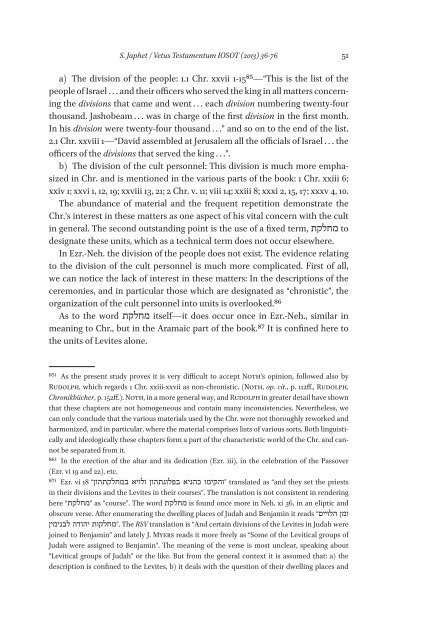Special Issue IOSOT 2013 - Books and Journals
Special Issue IOSOT 2013 - Books and Journals
Special Issue IOSOT 2013 - Books and Journals
You also want an ePaper? Increase the reach of your titles
YUMPU automatically turns print PDFs into web optimized ePapers that Google loves.
S. Japhet / Vetus Testamentum <strong>IOSOT</strong> (<strong>2013</strong>) 36-76 51<br />
a) The division of the people: 1.1 Chr. xxvii 1-1585—“This is the list of the<br />
people of Israel . . . <strong>and</strong> their officers who served the king in all matters concerning<br />
the divisions that came <strong>and</strong> went . . . each division numbering twenty-four<br />
thous<strong>and</strong>. Jashobeam . . . was in charge of the first division in the first month.<br />
In his division were twenty-four thous<strong>and</strong> . . .” <strong>and</strong> so on to the end of the list.<br />
2.1 Chr. xxviii 1—“David assembled at Jerusalem all the officials of Israel . . . the<br />
officers of the divisions that served the king . . .”.<br />
b) The division of the cult personnel: This division is much more emphasized<br />
in Chr. <strong>and</strong> is mentioned in the various parts of the book: 1 Chr. xxiii 6;<br />
xxiv 1; xxvi 1, 12, 19; xxviii 13, 21; 2 Chr. v. 11; viii 14; xxiii 8; xxxi 2, 15, 17; xxxv 4, 10.<br />
The abundance of material <strong>and</strong> the frequent repetition demonstrate the<br />
Chr.’s interest in these matters as one aspect of his vital concern with the cult<br />
in general. The second outst<strong>and</strong>ing point is the use of a fixed term, מחלקת to<br />
designate these units, which as a technical term does not occur elsewhere.<br />
In Ezr.-Neh. the division of the people does not exist. The evidence relating<br />
to the division of the cult personnel is much more complicated. First of all,<br />
we can notice the lack of interest in these matters: In the descriptions of the<br />
ceremonies, <strong>and</strong> in particular those which are designated as “chronistic”, the<br />
organization of the cult personnel into units is overlooked.86<br />
As to the word מחלקת itself—it does occur once in Ezr.-Neh., similar in<br />
meaning to Chr., but in the Aramaic part of the book.87 It is confined here to<br />
the units of Levites alone.<br />
85) As the present study proves it is very difficult to accept Noth’s opinion, followed also by<br />
Rudolph, which regards 1 Chr. xxiii-xxvii as non-chronistic. (Noth, op. cit., p. 112ff., Rudolph,<br />
Chronikbücher, p. 152ff.). Noth, in a more general way, <strong>and</strong> Rudolph in greater detail have shown<br />
that these chapters are not homogeneous <strong>and</strong> contain many inconsistencies. Nevertheless, we<br />
can only conclude that the various materials used by the Chr. were not thoroughly reworked <strong>and</strong><br />
harmonized, <strong>and</strong> in particular, where the material comprises lists of various sorts. Both linguistically<br />
<strong>and</strong> ideologically these chapters form a part of the characteristic world of the Chr. <strong>and</strong> cannot<br />
be separated from it.<br />
86) In the erection of the altar <strong>and</strong> its dedication (Ezr. iii), in the celebration of the Passover<br />
(Ezr. vi 19 <strong>and</strong> 22), etc.<br />
87) Ezr. vi 18 כהניא בפלוגתהון ולויא במחלקתהון“ ”והקימו translated as “<strong>and</strong> they set the priests<br />
in their divisions <strong>and</strong> the Levites in their courses”. The translation is not consistent in rendering<br />
here ”מחלקת“ as “course”. The word מחלקת is found once more in Neh. xi 36, in an eliptic <strong>and</strong><br />
ומן הלויים“ obscure verse. After enumerating the dwelling places of Judah <strong>and</strong> Benjamin it reads<br />
The RSV translation is “And certain divisions of the Levites in Judah were .”מחלקות יהודה לבנימין<br />
joined to Benjamin” <strong>and</strong> lately J. Myers reads it more freely as “Some of the Levitical groups of<br />
Judah were assigned to Benjamin”. The meaning of the verse is most unclear, speaking about<br />
“Levitical groups of Judah” or the like. But from the general context it is assumed that: a) the<br />
description is confined to the Levites, b) it deals with the question of their dwelling places <strong>and</strong>








![Am HaSefer [Volk des Buches] - Books and Journals](https://img.yumpu.com/20648352/1/174x260/am-hasefer-volk-des-buches-books-and-journals.jpg?quality=85)







